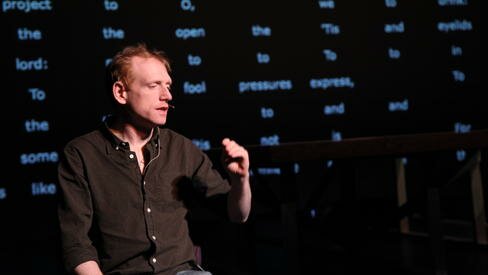
In A Piece of Work (formerly False Peach) Annie Dorsen aims to push the limits of the definition of theatre. For many in the audience at On The Boards on Thursday night she exceeded those limits. Some expressed this by walking out, others by nodding off. In the end the applause was sustained if polite.
Dorsen has given considerable thought to what she’s attempting in this work, most notably in her essay On Algorithmic Theatre (published in Yale’s Theater magazine, 42:3) but the theory is only valuable inasmuch as it plays out in performance.
The performance of A Piece of Work consists of two distinct parts. In the first part, which is less than a quarter of the running time, Scott Shepherd delivers a very present and deeply felt performance of a jumbled repetitive take on the text of Hamlet, focused mostly on the play’s (and perhaps all of theatre’s) most famous and iconic soliloquy. His performance is broken up by the projection of code on a drop upstage and seems derived from the algorithms associated with that code that drive the rest of the show.
The rest of the performance consists of words projected on that drop as they are vocalized by what sounds like computer-generated voices. The words are often accompanied by character names. Sometimes specific areas of the stage are illuminated and underscoring and sound effects are heard suggesting preordained relationships between words, sound, light, and atmosphere effects such as wind and fog.
Though much of the performance follows the chronology of Hamlet the words rarely hold together to follow Shakespeare’s script for more than a phrase or two. The algorithms that govern them would seem to be written to avoid clarity.
Dorsen’s essay suggests that she’s interested in engaging the audience by giving us work to do in order to form meaning, however she doesn’t give us enough sense of success in that work to feel any hope for satisfying achievement. The audience’s interest in the work gives way to boredom.
For those familiar with Hamlet much of the audience’s work is not so much in making meaning as reconstructing a pre-existing meaning. We attend with the expectation of a relationship with the play we know therefore we spend our energy looking for the familiar rather than creating the new. We reassemble the play in our minds, identifying a phrase and working to place it in the expected order and attach it to the appropriate character.
Great works of theatre often take a thing we know, whether a universal story or a well-known plot, and change small pieces of it in order to help us see it and our world anew. A Piece of Work takes the opposite approach, reordering the context and fabric of the piece to raise questions about larger structures including our understanding of the performer/audience relationship.
One way A Piece of Work jostles the performer/audience relationship is in its dependence on the written word. In this regard Shepherd’s involvement is striking as he is best known for his role in Elevator Repair Service’s Gatz. This highly lauded adaptation of The Great Gatsby is performed by actors who say every word of the novel as it comes to life in a workday spent waiting for computer repairs.
Shepherd, in the role of the narrator, Nick Caraway, had the lion’s share of the work in Gatz, which the New York Times’s Ben Brantley described as the “…layering of a novel’s world onto your own everyday environment” as when a novel “…so absorbs you that you start to imagine everyone around you as a character in it.” A Piece of Work does the opposite. Here the words disorient and disconnect as when attention drifts from the page and it suddenly becomes apparent that one has read the same passage several times over.
The projections of text make this as much a reading exercise as a performance. The words are performing objects, doubling their audible selves. The shape of the word Polonious becomes associated with an aggravated, aged voice delivering that character’s lines; it becomes the performing object or puppet of that character. The lights catch areas of the stage suggesting the place where those words are acted and the play unfolds. It is an extreme form of puppetry but is it theatre?
In her essay, Dorsen notes that “algorithmic performance creates an asymmetric relationship, in which the human spectator confronts something that can’t confront her back.” In other words, the performance is one-sided: the computer produces and the audience observes and responds.
Dorsen refers to Peter Brook’s suggestion that theatre requires no more than one person observing another. In performance A Piece of Work evinces the notion that this theory requires revision. In fact such theorists as Susan Bennett and Daphna Ben Chaim have suggested that the distinction between the theatrical and the simply performative lies in the communal interaction of performer and audience.
It is not enough for one person to watch another in order to make theatre. The observed must be aware of that observation and respond to it. Dorsen and company ask audiences to give their attention but we receive no attention in return and so the deal falls apart. A Piece of Work feels less like theatre than a temporal art installations in the dark corner of the museum that one peeks into for a time before walking out, which may be all we owe it.